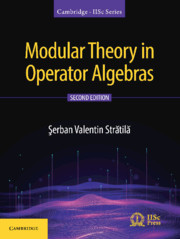Book contents
- Frontmatter
- Dedication
- Contents
- Preface to the Second Edition
- Preface to the First Edition
- Chapter I Normal Weights
- Chapter II Conditional Expectations and Operator-Valued Weights
- Chapter III Groups of Automorphisms
- Chapter IV Crossed Products
- Chapter V Continuous Decompositions
- Chapter VI Discrete Decompositions
- Appendix
- References
- Notation Index
- Subject Index
Chapter V - Continuous Decompositions
Published online by Cambridge University Press: 16 October 2020
- Frontmatter
- Dedication
- Contents
- Preface to the Second Edition
- Preface to the First Edition
- Chapter I Normal Weights
- Chapter II Conditional Expectations and Operator-Valued Weights
- Chapter III Groups of Automorphisms
- Chapter IV Crossed Products
- Chapter V Continuous Decompositions
- Chapter VI Discrete Decompositions
- Appendix
- References
- Notation Index
- Subject Index
Summary
Dominant Weights and Continuous Decompositions
Let be a properly infinite W*-algebra and denote by (resp.); resp. the set of all normal (resp. normal semifinite; resp. n.s.f.) weights on. In Sections 23.1–23.3, we consider a fixed weight and, using the canonical bijection given by Theorems 3.1 and 5.1, we apply the results obtained in Section 20 in order to get a comparison theory for weights. In particular, we define the notion of a dominant weight on, this yields the continuous decomposition of, the properties of which are analyzed further. The main feature of the continuous decomposition is that it reduces the study of type III W*-algebras to the study of actions of on semifinite W*-algebras, modulo (outer) conjugation.
Recall (2.21) that if and is a partial isometry with, then the Formula defines a weight with; moreover, if, then. Consider a fixed weight.
Proposition. Let and with and. Consider the W*-algebra and the balanced weight. The following statements are equivalent:
Proof. (i) ⇔ (ii). We have, and it also follows that; it also follows that. By Proposition
2.21, we have if and only. For, we have and, hence and only if.
(ii) ⇔ (iii). Consider now the W*-algebra and the weight defined as. Then by Proposition 3.3, we have
so that
hence if and only if for every.
If, then we have, and, so that the equivalence (ii) ⇔ (iii) also follows from Proposition 20.2.
By the previous proposition we have that for the following conditions are equivalent:
(i) there exists
(ii) there exists;
If these conditions are satisfied, we write and we say that the weight is dominated by the weigh. If in condition (i) we have also or, equivalently, in condition (iii) we have then we write and say that the weights and are equivalent. For the relations and we can thus apply all the results obtained in Section 20. In particular, If and, then.
Proposition. Let and be partial isometries such that. Then if and only if in.
Proof. Put. We have, and hence and, similarly,. Thus, we have to prove that if and only if in.
If in, there exists with and; hence, by Proposition 2.21.
Conversely, if then there exists with and.
- Type
- Chapter
- Information
- Modular Theory in Operator Algebras , pp. 331 - 368Publisher: Cambridge University PressPrint publication year: 2020



